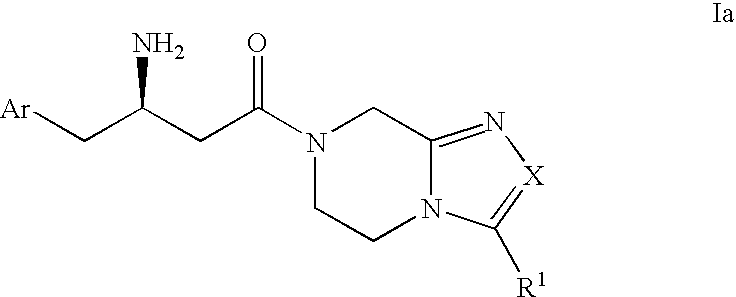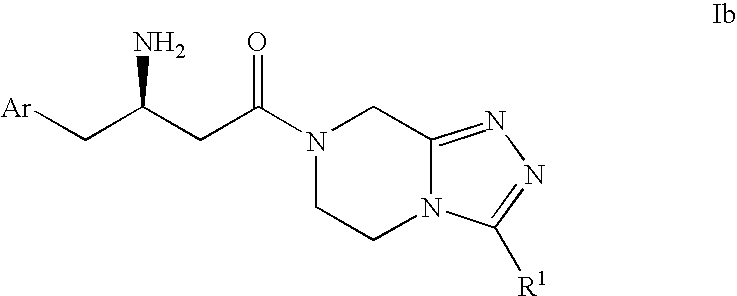Beta-amino tetrahydroimidazo (1, 2-a) pyrazines and tetrahydrotrioazolo (4, 3-a) pyrazines as dipeptidyl peptidase inhibitors for the treatment or prevention of diabetes
a technology of tetrahydroimidazo and pyrazines, which is applied in the direction of extracellular fluid disorder, metabolism disorder, immunological disorder, etc., can solve the problems of increased and premature morbidity and mortality, increased risk of macrovascular and microvascular complications in patients with type 2 diabetes mellitus, and increased plasma insulin levels
- Summary
- Abstract
- Description
- Claims
- Application Information
AI Technical Summary
Benefits of technology
Problems solved by technology
Method used
Image
Examples
example 1
[0191]
7-[(3R)-3-Amino-4-(3,4-difluorophenyl)butanoyl]-2-(trifluoromethyl)-5,6,7,8-tetrahydroimidazo[1,2-α]pyrazine, dihydrochloride
Step A. 2-(Trifluoromethyl)imidazo[1.2-α]pyrazine
[0192]To a solution of 2-aminopyrazine (5.25 g, 55.2 mmol) in ethanol (120 mL) was added 1-bromo-3,3,3-trifluoroacetone (5.73 mL, 55.2 mmol). The reaction was stirred at reflux for 20 h. After evaporation of solvent, the residue was partitioned between ethyl acetate and saturated aqueous sodium bicarbonate solution. The aqueous layer was extracted with ethyl acetate (3×). The combined organic phase was washed with brine, dried over magnesium sulfate and concentrated. The residue was purified by flash chromatography (silica gel, 1:1 ethyl acetate:hexane, then 100% ethyl acetate) to give 2.35 g of the title compound as a solid. 1H NMR (500 MHz, CDCl3) a 8.02 (m, 2H), 8.13(m, 1H, 9.22 (s, 1H). ESI-MS 188 (M+1).
Step B. 2-(Trifluoromethyl)-5,6,7,8-tetrahydroimidazo[1.2-α]pyrazine
[0193]To a solution of 2-(triflu...
example 2
[0197]
7-[(3R)-3-Amino-4-(2,5-difluorophenyl)butanoyl]-2-(trifluoromethyl)-5,6,7,8-tetrahydroimidazo[1,2-α]pyrazine, dihydrochloride
Step A. 7-[(3R)-3-[(1,1-dimethylethoxycarbonyl)amino]-4-(2,5-difluorophenyl)butanoyl]-5,6,7,8-tetrahydroimidazo[1,2-α]pyrazine
[0198]The title compound was prepared from 2-(trifluoromethyl)-5,6,7,8-tetrahydroimidazo[1,2-α]pyrazine (277 mg, 1.45 mmol, from Example 1, Step B), (3R)-3-[(1,1-dimethylethoxycarbonyl)amino]-4-(2,5-difluorophenyl)butanoic acid (Intermediate 1, 416 mg, 1.32 mmol), DIPEA (226 mg, 1.58 mol), HOBT (216 mg, 1.98 mol) and HATU (753 mg, 1.98 mol) in DMF (6 mL), using a procedure analogous to that described in Example 1 Step C, except for the purification method.
[0199]The compound was purified by preparative TLC (silica gel, 20% hexane in ethyl acetate, then 10% methanol in dichloromethane) to give 360 mg of the title compound as a foamy solid. 1H NMR (500 MHz, CDCl3) δ 1.35 (s, 9H), 2.62 (m, 2H), 2.88 (m, 2H) 3.88–4.16 (m, 5H), 4.73 (s,...
example 3
[0201]
7-T(3R)-3-Amino-4-(2,4,5-trifluoropheny)butanoyl]-2-(trifluoromethyl)-5,6,7,8-tetrahydroimidazo[1,2-α]pyrazine dihydrochloride
Step A. 7-[(3R)-3-[(1,1-dimethylethoxycarbonyl)amino]-4-(2,4,5-trifluorophenyl)butanoyl]-5,6,7,8-tetrahydroimidazo[1,2-α]pyrazine
[0202]The title compound was prepared from 2-(trffluoromethyl)-5,6,7,8-tetrahydroimidazo[1,2-α]pyrazine (31.7 mg, 0.166 mmol, from Example 1, Step B), (3R)-3-[(1,1-dimethylethoxycarbonyl)amino]4-(2,4,5-trifluorophenyl)butanoic acid (intermediate 3, 57 mg, 0.166 mmol), HOBT (26.9 mg,0.199) mmol, and EDC (47.8 mg, 0.249 mmol) in 4 mL of dichloromethane, using a procedure analogous to that described in Example 1, Step C. Purification by preparative TLC (silica gel, 100% ethyl acetate, then 10% methanol in dichloromethane) gave 40 mg of the title compound as a foamy solid. 1H NMR (500 Mz, CDCl3) δ 1.35 (s, 9H), 3.00 (m, 2H), 3.30 (m, 2H), 3.93 (m, 1H) 4.04–4.24 (m, 2H), 4.23 (s, 1H), 4.35 (m, 1H) 4.97–5.48 (m, 2H) 7.22 (m, 1H, 7.4...
PUM
| Property | Measurement | Unit |
|---|---|---|
| Fraction | aaaaa | aaaaa |
| Angle | aaaaa | aaaaa |
| Electrical conductance | aaaaa | aaaaa |
Abstract
Description
Claims
Application Information
 Login to View More
Login to View More - R&D
- Intellectual Property
- Life Sciences
- Materials
- Tech Scout
- Unparalleled Data Quality
- Higher Quality Content
- 60% Fewer Hallucinations
Browse by: Latest US Patents, China's latest patents, Technical Efficacy Thesaurus, Application Domain, Technology Topic, Popular Technical Reports.
© 2025 PatSnap. All rights reserved.Legal|Privacy policy|Modern Slavery Act Transparency Statement|Sitemap|About US| Contact US: help@patsnap.com



